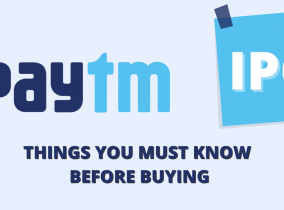
How to analyze an IPO
The past few months have seen a lot of companies vouching for the coveted listing on the Indian stock market. They have come from a plethora of sectors and for the first time some well-known startups have taken the jump too.
In these extremely bullish times it becomes imperative to analyze an IPO fundamentally in the correct way, and then take them into consideration for all actions rather than simply follow the herd mentality.
Here are some major headers to look into before taking that leap of faith and investing in an IPO:
1. Industry Analysis
- Industry Size, growth rates, and other recent developments
Investors often use a top-down approach that includes evaluating firstly the strength of the economy, followed by the relative strength of different sectors to judge whether an IPO in a particular sector is worth further analysis.
Taking industry size (in terms of the market size for the product/service) and coupling that with the industry growth (obviously higher growth sectors are preferable but they made trade at a premium) are good metrics to start one’s evaluation.
- Competitive Landscape
Post that one looks into the competitive landscape to determine how much market share the company can obtain. The factor of competitive advantage (in terms of brand name, product quality, etc.) also plays a key role in differentiation.
- Global Comparisons Vs India
This includes judging the growth prospects for the Indian market as a whole as compared to the global economy. One can also factor in global competitors and any barriers to entry they might face in order to potentially enter the Indian market.
2. Company Analysis
- Product Portfolio
This can include a fundamental analysis of the product in terms of quality, purpose, customer acceptance etc. Investors like Peter Lynch always advocate going for companies whose core products resonate with you.
- Manufacturing footprint & supply chain capabilities
Next comes their ability to produce and distribute their product. Looking at current manufacturing capabilities and scope for expansion, as well as any roadblocks they might face (eg: regulatory) is a good strategy for this bucket.
- Promoter & Management Profile
For many, the quality of management is the most important criterion for investing in a company. One is essentially then investing in the right people. An idea is worth nothing if not complemented with the correct execution. Looking at the past experience of the top management, and their current stance on the issue (are they selling off their stake?) can provide some key insights about the company’s longer-term prospects.
Another key factor here is corporate governance – how ethically and transparently is the management running the company? This can be judged by how clear their communication is with the shareholders.
- Customer Profile & History
For an in-depth analysis one can also look into the distribution of customers. This includes analysis of the concentration of Top 10 Customers (using for example contribution to revenue as the filter). This can help point out certain red flags. If a company has a customer base heavily concentrated in one geographical area, it may be a cause for concern. (because of the whole dont put all your eggs in one basket thing)
Apart from these looking into the company history and description,
The next major part to look into are the company’s financials. This includes analyzing the:
3. Profit and Loss Statement:
Major items here include top-line revenue, gross margins, and net profit after taxes.
Note: These items do not convey very much on a standalone basis. They need to be compared with direct competitors to get an understanding of the company’s position. Also, growth metrics (like top-line CAGR for 3 and 5 years) are used often too.
4. Balance Sheet:
The next statement to cover is the balance sheet to get an idea of the assets and liabilities and thus the networth (i.e equity) of the business. Investors tend to be wary of highly leveraged companies and thus the total and net debt is also important metrics to look into. (Note here again that some industries by nature require a higher proportion of debt, and so this again is a metric that cannot be used on a standalone basis. Utilities and financial services companies tend to have a higher debt-to-equity ratio. More on this below! )
Finally, the lifeline of a business is its cash reserve, and that plays a major role in judging the short-term solvency of a business.
5. Financial Analysis Tools:
A very important tool used in valuation especially by retail investors are some common ratios. Debt-Equity, Debt-EBITDA, Return on Equity (RoE) and Return on Capital Employed (RoCE) are some of the most important ratios to be considered.
For D/E and Debt/EBITDA taking into consideration, the industry is of utmost importance. This is because some industries are more capital intensive than others (think oil and gas). Within a particular industry, a higher Debt/Equity may indicate that a company is riskier.
Another factor to look into here is if the unit economics work. Simply put if the amount earned per transaction exceeds the cost of the transaction, and by how much. (The Zomato IPO and its unit economics were a major point of discussion!)
Finally, a company may be the absolute greatest company of all time, but if it is not being offered at the right price it is not a buy. Here again analysing the multiples of comparable companies already trading is required. We strongly recommend using a 3-Year Forward as the go-to-choice for this analysis. One can use this to judge whether the company in question is trading at a premium or discount to fair value (i.e if it is overvalued or undervalued)
Again, do be cautious of the companies being used for comparison – a similar growth and return profile needs to be met to then make the judgement of relative valuation.
Apart from this a few other considerations include:
- Why the company has gone public – the funding requirement could be due to expansion, paying off debt or meeting the working capital requirements. The first two provide a solid enough reason to invest as the prospects will definitely look brighter post-funding, the third however is slightly tricky to objectively evaluate!
- What the promoters are doing – while a fresh issue implies raising new capital, an offer for sale means the existing investors are selling off their stake. The latter could obviously signal a red flag and the management’s lack of faith in the company’s future prospects.
Having said this, investing in IPOs is tricky stuff. However if one is clear about their investment goals and confident in their style of trading, it can do wonders for them. The initial uncertainties can be exploited to make a quick gain. However getting a thorough understanding of the companies’ fundamentals and then basing all decisions on those insights will always be the most profitable route to go down!
Tags:IPO
Previous








